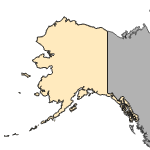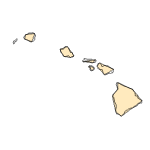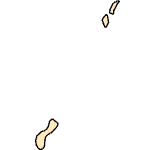Chelus fimbriata
(Matamata Turtle)
Reptiles-Turtles
Exotic |
|
Common name: Matamata Turtle
Synonyms and Other Names: caripatua, mata, doctor galap
Taxonomy: available through
www.itis.gov
Identification: No other turtle looks as bizarre and unmistakable as Chelus fimbriatus. An adult matamata can reach an overall carapace (upper shell) length of 310-450 mm (12.2-17.7 in) and weigh up to 17.2 kg (about 38 lbs) (Pritchard and Trebbau, 1984; Lamar, 1997; Obst, 1998). The rough carapace is black or brown, with serrated edges, and the plastron is relatively small (Ernst and Barbour, 1989). The seemingly grotesque, flattened, triangular head has a startlingly wide mouth, long tubular nose, tiny eyes, numerous tubercles, and fleshy flaps protruding from the sides; additional tubercles and lateral flaps of skin adorn the elongate neck (Pritchard, 1979; Pritchard and Trebbau, 1984; Obst, 1986; Ernst and Barbour, 1989; Pough et al., 2001). Juveniles may have pink and black stripes on the underside of the neck (Pritchard and Trebbau, 1984; Ernst and Barbour, 1989). These odd, tropical chelids (Australo-American sideneck turtles) are illustrated in a variety of publications (Pritchard, 1979; Freiberg, 1981; Pritchard and Trebbau, 1984; Obst, 1986; Alderton, 1988; Ernst and Barbour, 1989; Cleave, 1994; Lamar, 1997; Murphy, 1997; Fogel, 1998; Crump, 2000).
Size: carapace length of 310-450 mm
Native Range: The indigenous range of the matamata includes much of northern and central South America; the Amazon and Orinoco basins extending into Brazil, Bolivia, Colombia, Ecuador, Venezuela, Peru, and associated coastal rivers in the Guianas including Guyana, French Guiana, and perhaps Trinidad (Pritchard and Trebbau, 1984; Ernst and Barbour, 1989; King and Burke, 1989; Iverson, 1992; Murphy, 1997). Whether there is an established colony on Trinidad or just occasional, migrant waifs has not been verified (Murphy, 1997).



|

Alaska |

Hawaii |

Puerto Rico &
Virgin Islands |

Guam Saipan |
Hydrologic Unit Codes (HUCs) Explained
Interactive maps: Point Distribution Maps
Nonindigenous Occurrences:
Prior to 1964, five matamata were released into Pembroke Park, at the intersection of Pembroke Road and U.S. Highway 95, Broward County, Florida, U.S. (King and Krakauer, 1966; Smith and Kohler, 1978).
Table 1. States with nonindigenous occurrences, the earliest and latest observations in each state, and the tally and names of HUCs with observations†. Names and dates are hyperlinked to their relevant specimen records. The list of references for all nonindigenous occurrences of Chelus fimbriata are found here.
Table last updated 12/18/2025
† Populations may not be currently present.
Means of Introduction: These turtles were intentionally released by an animal dealer (King and Krakauer, 1966).
Status: The status of the C. fimbriatus released in Broward County, Florida, has remained unreported since their release (King and Krakauer, 1966). They undoubtedly failed to establish a colony; however, I have heard persistent, unverified rumors of a breeding population of matamata in South Florida for at least the last 15 years (personal observation).
Impact of Introduction: Should any matamata establish themselves in Florida, they could potentially impact indigenous aquatic ecosystems.
References: (click for full references)
Alderton, D. 1988. Turtles & Tortoises of the World. Facts on File, Inc., New York. 191 pp.
Cleave, A. 1994. Snakes & Reptiles. A Portrait of the Animal World. Todtri Productions Limited, New York. 80 pp.
Crump, M. [L.] 2000. In Search of the Golden Frog. The University of Chicago Press, Chicago and London. 299 pp.
Ernst, C. H., and R. W. Barbour. 1989. Turtles of the World. Smithsonian Institution Press, Washington, D.C. and London. 313 pp.
Fogel, D. 1998. Notes on the captive husbandry of the matamata (Chelus fimbriatus). Reptile & Amphibian Magazine (53):64-65, 67.
Freiberg, M. 1981. Turtles of South America. T.F.H. Publications, Inc., Neptune, New Jersey. 125 pp.
Iverson, J. B. 1992. A Revised Checklist with Distribution Maps of the Turtles of the World. John B. Iverson, Richmond, Indiana. 363 pp.
King, F. W., and R. L. Burke (editors). 1989. Crocodilian, Tuatara, and Turtle Species of the World. A Taxonomic and Geographic Reference. The Association of Systematics Collections, Washington, DC. 216 pp.
King, [F.] W., and T. Krakauer. 1966. The exotic herpetofauna of southeast Florida. Quarterly Journal of the Florida Academy of Sciences 29(2):144-154.
Lamar, W. W. 1997. The World's Most Spectacular Reptiles & Amphibians. World Publications, Tampa. 210 pp.
Mittermeier, R. A., F. Medem, and A. G. J. Rhodin. 1980. Vernacular names of South American turtles. Society for the Study of Amphibians and Reptiles Herpetological Circular (9):1-44.
Murphy, J. C. 1997. Amphibians and Reptiles of Trinidad and Tobago. Krieger Publishing Company, Malabar, Florida. 245 pp. + 172 plates.
Obst, F. J. 1986. Turtles, Tortoises and Terrapins. St Martin's Press, New York. 231 pp.
Obst, F. J. 1998. Turtles & tortoises. Pp. 108-125. In: H. G. Cogger and R. G. Zweifel (editors). Encyclopedia of Amphibians & Reptiles. Second Edition. Academic Press, San Diego. 240 pp.
Pough, F. H, R. M. Andrews, J. E. Cadle, M. L. Crump, A. H. Savitzky, and K. D. Wells. 2001 [2000]. Herpetology. Second Edition. Prentice Hall, Upper Saddle River, New Jersey. 612 pp.
Pritchard, P. C. H. 1979. Encyclopedia of Turtles. T.F.H. Publications, Inc., Neptune, New Jersey. 895 pp.
Pritchard, P. C. H., and P. Trebbau. 1984. The Turtles of Venezuela. Contributions to Herpetology 2. Society for the Study of Amphibians and Reptiles, Ithaca. 403 pp., 47 plates, 16 maps.
Smith, H. M., and A. J. Kohler. 1978. A survey of herpetological introductions in the United States and Canada. Transactions of the Kansas Academy of Science 1977 80(1-2):1-24.
Author:
Somma, L.A.
Revision Date: 10/22/2019
Citation Information:
Somma, L.A., 2025, Chelus fimbriata (Schneider, 1783): U.S. Geological Survey, Nonindigenous Aquatic Species Database, Gainesville, FL, https://nas.er.usgs.gov/queries/factsheet.aspx?SpeciesID=1223, Revision Date: 10/22/2019, Access Date: 12/18/2025
This information is preliminary or provisional and is subject to revision. It is being provided to meet the need for timely best science. The information has not received final approval by the U.S. Geological Survey (USGS) and is provided on the condition that neither the USGS nor the U.S. Government shall be held liable for any damages resulting from the authorized or unauthorized use of the information.